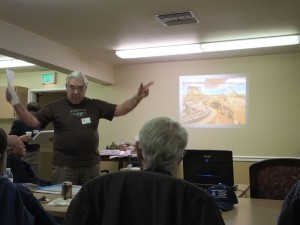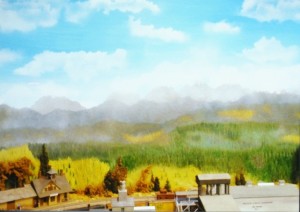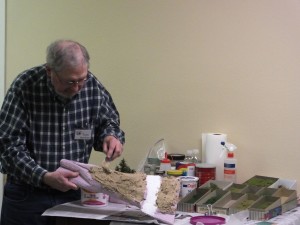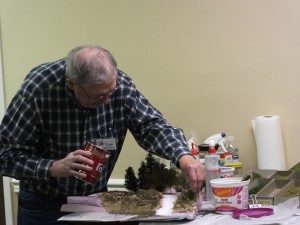Article and Photos by Al Carter
Chairman Rich Blake opened the meeting promptly at 7:00 and mentioned he and Susan Gonzales are soliciting ideas for clinic topics for the 2014-2015 season. Al Carter gave an update on the upcoming PSX-2014 PNR Convention. The evening’s program was another “two-fer” – two of our finest clinicians gave outstanding talks on Backdrops (Jack Tingstad) and Scenery (Tom Hawkins).

No, Jack is not leading the choir, but is making a point in his backdrop clinic
Jack started off with a remark that backdrops should not be the focal point of a layout, but rather, they should compliment the three dimensional scenery and add depth to scenes. Jack used tempered hardboard (Masonite) as his “palette” and painted it a blend of sky blue colors, darker towards the top and lighter towards the bottom.
New London Industries makes stencils for spray painting backdrop elements, including clouds, mountains, hills, trees (and even a city skyline), and Jack very successfully employed all but the city skyline stencil on his exquisite Cloud City & Western HO layout. These stencils are available on line; Jack mentioned that Fifer Hobby carries them.
Spray paint (rattle cans) are the medium of choice with the stencils, and the cans are a lot easier to use if you use a spray can handle, available at paint stores. Tip: Use carburetor cleaner to clean out those clogged nozzles!

Part of the outstanding backdrop on the Cloud City & Western layout of Jack Tingstad. Note the seemingly distant hills
After each “layer” of scenery is sprayed on the backdrop (starting from the distant mountains/hills, and working closer to the viewer), Jack sprays a fine mist of white or light gray paint to sort of add some haze to the scene. It really adds some depth to the backdrop, and sort of pushes the distant mountains further away from the viewer.
Jack uses tube acrylics when painting some foreground scenery, such as trees, and remarked that “fan brushes” are absolutely a requirement for painting trees, especially evergreen trees.
Also essential is the use of reference material before you start slinging paint on your pristine blue backdrop – images on the internet, as well as calendar photos, are a great resource.
Back to clouds, Jack remarked that “there are no bad clouds” – you can’t really screw up a cloud – just look skyward at the huge variety of clouds we so frequently see in our neck of the woods!

Tom Hawkins spreading Ground Goop on a demonstration diorama base
Tom took over the stage next, and took us through all the steps necessary to complete a nicely scenicked hillside. Tom, who is famous locally because he won third place in the Model Railroader layout planning contest in October, 2012, had pre-built a small scenic base out of pink Styrofoam, 1” thick pieces glued together in several layers sloping towards the rear.
Tom is a proponent of “Ground Goop”, which is a concoction that can be troweled on to a base to add texture and fill in gaps, etc. This method has been around for decades and has proven it’s worth and popularity. The recipe is 1 cup Celluclay, 1 cup Sculptamold (both available on-line or at craft stores), 1 cup brown or tan latex paint, and 1/3 cup Elmer’s white glue (and 1 capful of Lysol to act as a mold deterrent if you are going to store unused, mixed goop for a while). It will keep, properly covered, for several days or even weeks.

Tom Hawkins adding ground cover over Ground Goop
Tom trowels it into place, then sprinkles non-sanded tan or brown grout over the wet goop to add texture. He follows up with a variety of ground cover, including ground up leaves from his yard, tea leaves, and commercially available products.
Planting trees in Ground Goop is easy as the goop base provides a stable material to poke holes in for tree trunks (unlike hardshell hydrocal, which is thin and brittle and doesn’t support tree trunks well).
Both Jack’s and Tom’s presentations were outstanding and I heard more than one individual say he/she was anxious to get home and try these techniques out.
Next month, on March 12, Stathi Pappas, the Chief Maintenance Officer for the Mount Rainier Scenic Railway, will be our guest clinician, talking about operations on the railroad and restoring steam locomotives. Be sure mark your calendars!





